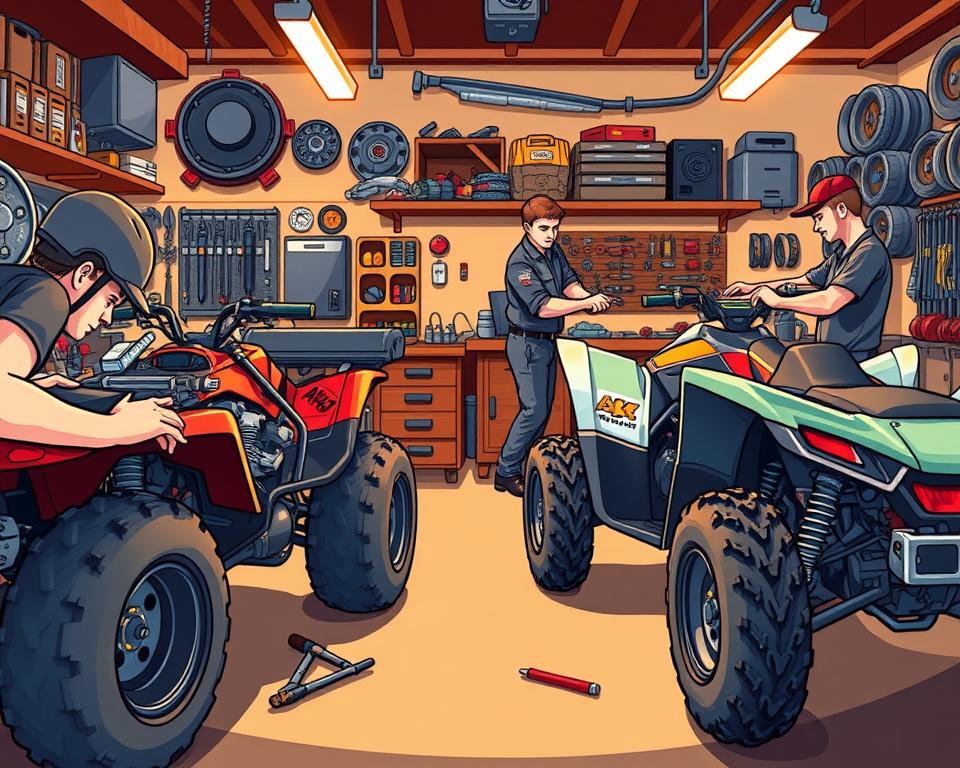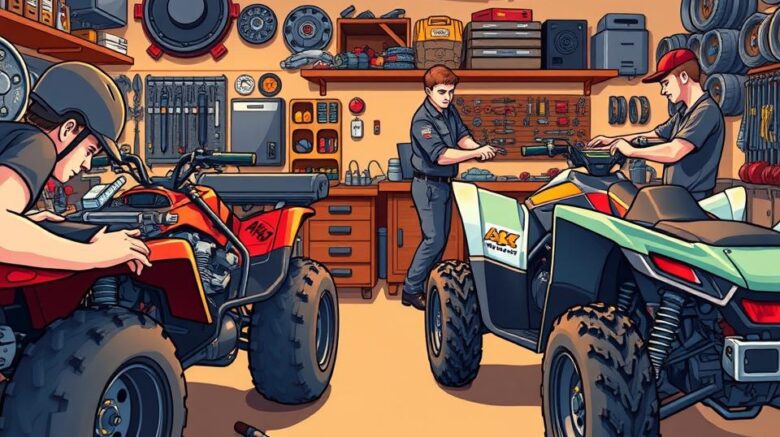How New Riders Can Avoid ATV/UTV Gear Selection Pitfalls
It might surprise you to discover that nearly 20% of new ATV and UTV owners face gear selection issues within their first year? Such data emphasizes how critical gear ratios are for novice riders. It’s not just about performance; it’s also about safety on the trails. Let’s dive into gearing missteps, care routines, and top highlifter ATV tips to enhance your rides.
Summary Highlights

- Understanding gear ratios is vital for optimal ATV/UTV performance.
- Neglecting gearing details increases accident hazards.
- Routine care averts transmission breakdowns.
- Proper gear selection greatly enhances off-road riding experiences.
- Applying service recommendations increases longevity.
Understanding ATV and UTV Gear Ratios
ATV/UTV gear ratios dictate how power meets torque. They govern both top speed and hauling capacity. This affects acceleration and the vehicle’s ability to pull loads. By picking specific ratios, you tailor your ride for drag, trail, or work.
Selecting proper gears unlocks engine potential. Too low a ratio may leave you underpowered on inclines. Conversely, too high a ratio hampers quick takeoffs on flats.
Many enthusiasts use gear reduction to enhance handling and adaptability across different terrains. Ratio mods shape how your rig behaves off-road. It perfectly aligns performance with your riding style. Optimal ratios deliver smoother use and better MPG.
Common Gearing Oversights for New ATV/UTV Owners
Correct gearing secures top output and trail safety. Rookies often miss key selection factors. Knowing what happens when you misgear and how to fix it transforms your experience. And it sidesteps needless breakdowns.
Impact of Incorrect Gear Selection
Choosing the wrong gear can lead to serious problems, including loss of control and mechanical failures. Incorrect ratios reduce pulling power, hamper braking, and grind parts. Such errors endanger everyone, from driver to bystanders. Using maintenance best practices wards off these hazards.
Choosing the Right Gear for Terrain
Each surface demands its own ratio. Climbing requires low-end grunt from smaller ratios. On flat terrains, higher gears help increase speed. In muddy or sandy conditions, choosing the right gear is essential for traction and stability. Recognizing terrain traits delivers safer, smoother rides.
The Importance of Proper ATV Maintenance
Routine upkeep ensures reliable performance. Adhering to care guides prevents sudden failures and enhances safety. A smart maintenance regimen targets gearbox longevity.
Regular Inspection and Maintenance
A thorough inspection list catches troubles before they grow. Routinely examine gearbox teeth, brake pads, rubber, and belts. By making this checklist a part of your routine, you can greatly enhance your vehicle’s performance. Here are some critical inspection points to remember:
- Examine gear alignment and wear.
- Ensure all fasteners are tight.
- Check master cylinder and calipers for leaks.
- Measure wheel pressure and wear.
- Check wiring and connectors for rust.
Fluid Changes and Gear Health
Fresh oils ensure the gearbox stays healthy. Routine fluid swaps avoid sludge and varnish. Fresh oil cuts wear and heat for lasting components. Using this method secures dependable function and fewer breakdowns.
| Fluid Type | Recommended Change Interval | Benefits of Regular Change |
|---|---|---|
| Motor Oil | 50–100 operating hours | Cuts friction and boosts power |
| Differential Oil | 100–200 operating hours | Improves shifting, minimizes gear damage |
| Coolant | Once per year | Stops boil-overs and freezes |
Adhering to this schedule grants worry-free adventures. This makes every journey more enjoyable.
Common ATV Gear Shifting Problems
Rookie riders struggle with smooth shifts. Developing fluid shift skills elevates trail enjoyment. This stops shift-related aggravation. Timing throttle and clutch releases prevents gears from crunching.
Learning to Shift Smoothly
Building graceful shift habits demands consistent effort. Start by getting to know your ATV engine’s rhythm. Careful engagement protects internals and stops wear. Blending throttle with clutch release ensures seamless shifts.
Rehearse gear changes in a safe area before heading out. Focus on gentle throttle application during each gear change.
Recognizing Signs of Gear Issues
Catching faults early saves time and money. Be alert for clicks, clunks, or grinds when shifting. Hard shifts or missed gears indicate trouble. Addressing issues promptly protects components and riders. Addressing ATV gear shifting problems properly maintains vehicle performance and boosts your confidence while riding.
Understanding UTV Transmission Issues
Transmission headaches are common; understanding them aids fixes. Typical troubles involve gears that slip and grinding sounds. Here we examine usual faults and outline a step-by-step fix plan. Drawing on proven UTV repair protocols.
Diagnosing Common Problems
Noticing early clues saves you from expensive repairs. Common issues include:
- Unexpected gear drops that compromise handling.
- Strange noises signaling internal wear.
- Leaking transmission fluid, potentially leading to more severe problems.
Scheduled inspections catch problems fast. This allows for prompt action. Ignoring these signs can lead to expensive repairs and reduced performance.
Solutions for Troubleshooting UTV Transmissions
Solving drivetrain faults depends on a structured routine. Follow these steps for effective troubleshooting:
- Verify oil levels and refill as needed.
- Look for wet spots beneath the transmission.
- Assess internal components for wear or chipping.
- Test drive the UTV at various speeds to monitor gear engagement and responsiveness.
- Consult the owner’s manual for specific diagnostics related to your model.
Following a reputable repair manual simplifies diagnosis. Understanding gear mechanics is key for any UTV owner. This knowledge boosts lifespan and performance.
ATV Clutch Adjustments and Their Benefits
Proper ATV clutch adjustments are key to a great riding experience. Incorrect adjustments can make shifting gears tough, frustrating for beginners. Routine calibration refines clutch response and engagement.
Adjusting gears with precision is vital. An optimally adjusted clutch ensures quick and smooth gear changes. It refines acceleration and comfort across all conditions.
Skipping clutch care leads to early failures and poor shifts. Regular tuning keeps shifts sharp and the motor lively. All riders benefit from clutch care to maintain top performance.
Mastering the Art of Gear Shifting
Becoming adept at shifts transforms your off-road sessions. Understanding drivetrain function and shift timing is crucial. Beginners should focus on the rhythm of shifting gears. A steady shift rhythm yields cleaner transitions and more power.
Proficient gear shifting demands practice, across various riding conditions. Recognizing terrain-specific shift cues boosts confidence and protection. For instance, shifting down when approaching a steep hill helps maintain power and stability.
- Rehearse clicks slowly to gain control.
- Note engine tone and drivetrain reaction.
- Gradually incorporate more challenging terrains to test your skills.
Tuning into your ATV’s feedback is key to shift mastery. Pay attention to engine sounds and vibrations. These cues pinpoint exact shift timing. Such intuitive understanding leads to proficient gear shifting, making your ride more enjoyable.
Best Practices for UTV Gear Selector Problems
Tackling selector issues calls for scheduled checks and troubleshooting. Routine linkage reviews catch wear promptly. By mastering gear selection techniques, operators can avoid malfunctions. Inspect link rods and fluid status as part of every service.
At the first sign of trouble, clear debris from the shifter. Unusual noises can also hint at problems. Simple adjustments and cleaning often solve issues without needing major repairs. Scheduled servicing prevents selector degradation.
Tracking shift quality across terrains isolates faults. These best practices not only extend the gear selector’s life but also make riding safer and more enjoyable.
Tips for Enhancing Gear Performance
Sustaining peak gear health involves systematic care. Regular maintenance is key to improving ATV efficiency. It’s important to check fluid levels, inspect for wear, and adjust settings as needed. Catching nicks before they worsen saves you big bucks.
Selecting proper reductions yields prompt acceleration and fluid movement. Understanding the terrain you will face allows you to select the appropriate ratios. It influences your launch and maximum velocity. Consulting reputable brands like American Off-Roads, which offer aftermarket modifications, can help with UTV performance enhancements.
Implementing gear performance tips in wheels, springs, and ballast optimization elevates function. These tweaks guarantee superior handling in rough conditions. Your rides become more fun and less fatiguing. These steps ensure fearless exploration and maximum excitement on the trail.
The Final Word
Nailing gear selection unlocks peak power and protection. Matching gears to ground types transforms your adventure. Dodging typical pitfalls and choosing wisely delivers memorable, safe outings.
You can’t overemphasize regular service for power health. Regular checks and upkeep are key to avoiding problems and extending your vehicle’s life. Proper care boosts efficiency and keeps you safe in diverse environments.
Combining correct gearing with scheduled service delivers peak satisfaction for riders. Embracing these tips sets the stage for countless epic journeys.
Frequently Asked Questions
What are the typical gear ratios for ATVs and UTVs?
ATVs and UTVs have gear ratios that vary widely, depending on the model. They usually range from 3:1 to 5:1. Smaller ratios deliver grunt for trails and climbs. Taller ratios boost runway speed on level ground.
Signs of misgearing for different surfaces?
Using the wrong gear can lead to loss of control, excessive engine revving, or poor acceleration. Different grounds need dedicated ratios to maintain traction and speed.
How to know when your machine needs service?
Pay attention to hard shifts, strange sounds, leaky fluid, or waning torque. Periodic drive train reviews ward off costly repairs.
How often should I change the fluids in my ATV/UTV gear system?
Change the gear fluids every 1,500 to 2,500 miles, or at least once a year, depending on usage and terrain. Clean fluids ensure efficient gear operation and extend drivetrain life.
What techniques should I use for smooth gear shifting?
Sync your revs and clutch for seamless gear changes. Feather the clutch up while winding the throttle for a perfect match.
Steps to diagnose gearbox problems?
Start by checking for common problems like slipping gears or strange noises. Verify oil clarity and fill. Then, perform a basic diagnostic to identify any mechanical failures.
What is the importance of clutch adjustments in an ATV?
Well-set clutches ensure crisp gear changes. An improperly set clutch can cause shifting difficulties and may lead to premature wear on transmission components.
Optimizing gears for varied ground?
Experiment with various gear ratios and consider aftermarket modifications from reputable brands like American Off-Roads. Routine upkeep—fluid swaps and gear checks—boosts efficiency.
Addressing a bad gear selector?
Scheduled upkeep resolves most shifter faults. If you encounter issues with a stuck selector or improper gear engagement, consult the troubleshooting guide in your owner’s manual for step-by-step diagnostics.
What common mistakes should new ATV/UTV owners avoid?
New owners often overlook the importance of understanding gear ratios, neglect routine maintenance, or fail to adjust gears according to terrain. These mistakes hamper performance and raise the chance of mishaps.
